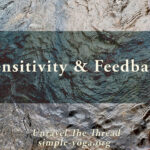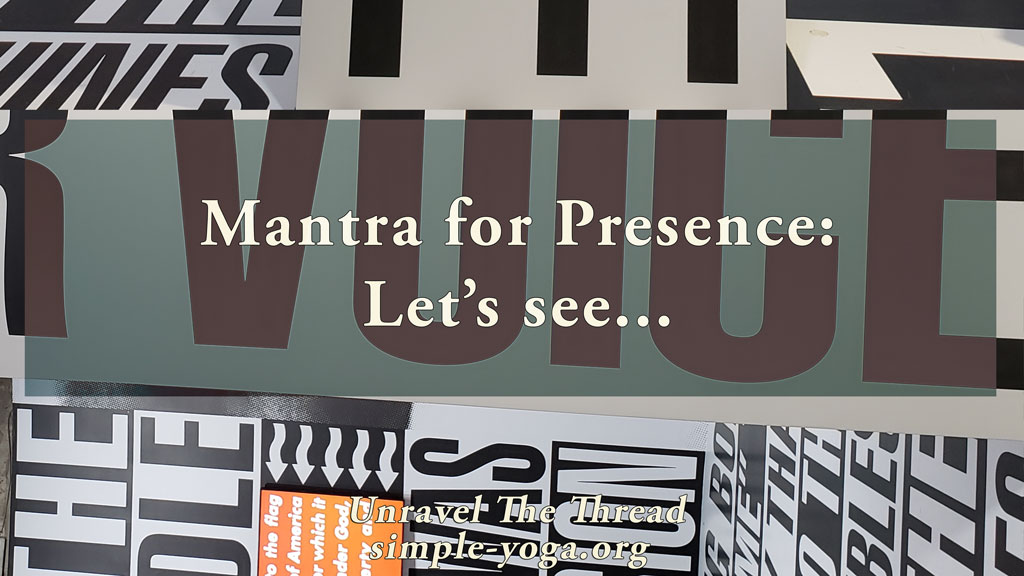
Sensitivity and feedback
May 10, 2024
Can I choose to be happy?
July 16, 2024
Sensitivity and feedback
May 10, 2024
Can I choose to be happy?
July 16, 2024A mantra for presence

A mantra for presence
We return again and again to this simple idea: yoga is a lifelong journey toward presence. All yoga techniques aim to bring us into full participation in the eternal present moment. Traditionally, mantra is a way of inviting our attention to this moment through the repetition of a word or phrase. Usually this repetition (japa) requires some effort to keep our mind rooted in the present. When the mind remains aware of the mantra, its meaning and significance, without repeating the mantra, it is called ajapa, or ajapajapa. In other words, the habit of repeating the mantra with awareness and conviction anchors a part of our mind to the mantra. It can serve as a gentle reminder of a broader perspective on our lives.
As with all techniques and tools, it is wise to ask: do mantras work? Although mantra is originally a Sanskrit word, many languages have added the word mantra to their dictionaries. In addition to its original meaning in yoga, Hinduism, and Buddhism, a common definition of mantra is a frequently repeated word or phrase. If we pay attention to our own words in our daily interactions, we will probably notice that there are some words that we use frequently. For example, we may find that we often say things like, “Here are the things we need to worry about,” “Our biggest worry is…” or “I’ll worry about that later.” Is it possible that by using the word worry often, we are priming our minds to go into worry mode? This is an empirical question, something we can easily determine. Even if we sit for just a few minutes and repeat “I am worried” over and over again, we will probably find that we feel different than if we repeat “I am at peace” for a few minutes.
If our words influence our thoughts, attitudes and perceptions, it is important for us to notice what words we say, consciously and unconsciously, because these words become the mantras we use in our daily lives. Some of our unconscious mantras can pull us away from the present, such as choosing to worry about things that have not yet happened, or assuming that we already know how things will turn out, taking our assumptions as facts, and reacting to events that have not yet happened.
All mantras, like all tools in yoga, are tools to bring us into the present. When we are aware all the time, there is no need for tools, we just are, and we participate in our lives from our presence, rather than from our habits, propensities, inclinations, beliefs, and other ways of being. Is it really so difficult to be present? In short, no, it isn’t. Either we are present or we are not. When we notice that we are not present, we drop the distraction, whatever it may be, and we return to presence. As we have suggested before, this is the key practice, returning to presence again and again without strain, without struggle, without self-judgment, and with a gentle smile. In searching for ways to apply the Yoga Sutras of Patañjali, we found several ways to use mantras, including the mantra ॐ (AUM) in Sutra 1.27, as a support in meditation in Sutra 3.2 , and we also explored mantras for applying the yamas and niyamas.
We mentioned earlier that one of the ways we distract ourselves is by believing that we can accurately predict the future. It is safe to say that we are not good at predicting. This is because everything, literally everything, is constantly changing, the world around us is changing. Even our bodies, minds, ideas, beliefs, and memories change. Life is constant change, so it makes sense that our predictions are not very accurate. We can still try to predict, but it seems useful not to get attached to our predictions. This is easier if we examine our past predictions and recognize that our past predictions have never been very accurate.
It is important to clarify that we are not suggesting that one should never think about the future. It makes sense that it is useful to plan or have a general awareness of the future so that we can prepare. For example, if I know I have to go to a place that is far from home, it is helpful to check if I have enough gas or charge to get there and back. Some of our tendencies may lead us to imagine that the trip will be good, bad, neutral, or disastrous. When we catch ourselves spending too much energy or time worrying about a possible outcome, we can use a very simple mantra: “Let’s see.” Here are some ideas for using this mantra. Any time you find yourself spending a lot of energy trying to predict how something will happen, consider pausing, taking a breath, and saying, let’s see. If you find yourself worrying about how something will turn out, notice if anything feels different when instead of worrying you invite yourself into the present by saying let’s see. Notice how this simple mantra invites us to pay attention to what is happening while acknowledging that we do not yet know how the future will unfold.
Can this simple mantra make a difference? As always, these suggestions offer ideas that you can try out for yourself to see if they enhance your ability to participate in your life with awareness.
Will it work for you? Let’s see…
If you prefer, you may listen to the podcast:
This is an excerpt from the book Unravel the thread: Applying the ancient wisdom of yoga to live a happy life
If you find Simple-Yoga.org and Unravel the thread useful, consider supporting my labor with a donation, you may also donate using PayPal or Venmo. Thank you!
